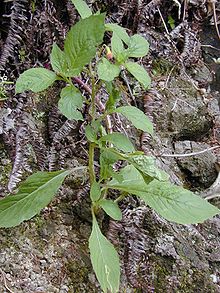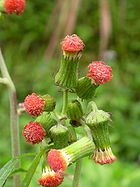- Crassocephalum crepidioides
-
Crassocephalum crepidioides 
Crassocephalum crepidioides Scientific classification Kingdom: Plantae (unranked): Angiosperms (unranked): Eudicots (unranked): Asterids Order: Asterales Family: Asteraceae Tribe: Senecioneae Genus: Crassocephalum Species: C. crepidioides Binomial name Crassocephalum crepidioides
(Benth.) S. MooreCrassocephalum crepidioides, also called ebolo, thickhead, redflower ragleaf, or fireweed, is an erect annual slightly succulent herb growing up to 180 cm tall. Its use is widespread in many tropical and subtropical regions, but is especially prominent in tropical Africa. Its fleshy, mucilaginous leaves and stems are eaten as a vegetable, and many parts of the plant have medical uses. However, the safety of internal use needs further research due to the presence of plant toxins. [1]
Toxicity
C. crepidioides contains the hepatotoxic and tumorigenic pyrrolizidine alkaloid, jacobine.[2][1]
References
- ^ a b Grubben,G.J.H., Vegetables, Volume 2 of Plant Resources of Tropical Africa, PROTA 2004, ISBN 9057821478
- ^ Fu, P.P., Yang, Y.C., Xia, Q., Chou, M.C., Cui, Y.Y., Lin G., "Pyrrolizidine alkaloids-tumorigenic components in Chinese herbal medicines and dietary supplements", Journal of Food and Drug Analysis, Vol. 10, No. 4, 2002, pp. 198-211[1]

This Senecioneae-related article is a stub. You can help Wikipedia by expanding it.

